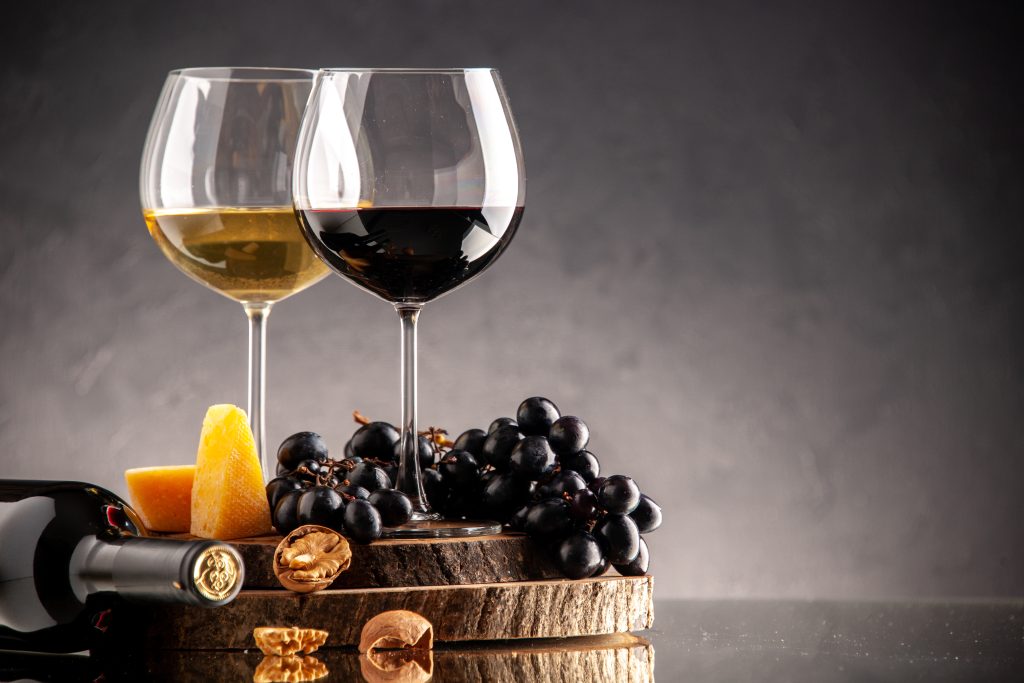Are you curious about the difference between red and white wine? Whether you’re a wine enthusiast or just starting to explore, understanding the distinctions can enhance your appreciation. In this article, we’ll delve into the key factors that set red and white wines apart. From grape varieties to production processes, we’ll explore the elements that contribute to their unique characteristics. You’ll discover how red wines, made from red and black grapes, differ from white wines, typically made from white grapes. Let’s uncover the secrets of red and white wine together.
Contents
Types of Wine
When it comes to understanding the difference between red and white wine, it’s important to have a clear understanding of the types of wine available. Red wine is known for its bold, rich flavors and higher tannin levels, which contribute to its dry mouthfeel. Popular red wine varieties include Cabernet Sauvignon, Merlot, Pinot Noir, and Syrah. These wines often have aging potential, meaning they can improve with time and develop more complex flavors. Red wines also exhibit a wide range of aromas and bouquets, from fruity and floral to earthy and spicy. Different wine regions around the world produce unique red wines, each with its own distinctive characteristics. Understanding wine terminology, such as terms like “varietal” and “appellation,” can help you navigate the world of red wines and make informed choices.
On the other hand, white wine is known for its crisp, light, and refreshing characteristics. It is typically made from white grape varieties such as Chardonnay, Sauvignon Blanc, and Riesling. White wines are not as tannic as red wines, and they are often enjoyed when young and fresh. While some white wines can benefit from aging, they are generally consumed within a few years of their release. White wines offer a wide range of aromas and bouquets, including citrus, floral, and tropical fruit notes. Like red wines, white wines are also influenced by their respective wine regions, each offering distinct flavors and styles. Understanding the different types of white wines and the regions they come from can help you appreciate the variety and complexity of this wine category.
Grape Varieties
Now let’s talk about the grape varieties that contribute to the unique flavors of red and white wines. Some popular red grape varieties include Merlot, Pinot Noir, Shiraz, and Grenache. Each grape variety brings its own characteristics and nuances to the wine, resulting in a wide range of flavors and aromas. Understanding these grape varieties can help you explore and appreciate the diverse world of red and white wines.
Merlot
Merlot is a popular red grape variety used in the production of red wine. It is often compared to Cabernet Sauvignon, another well-known red grape variety. Here are some key points about Merlot:
- Merlot vs Cabernet: Merlot is generally considered to be softer and less tannic than Cabernet Sauvignon, making it more approachable and easier to drink at a younger age.
- Merlot food pairings: Merlot pairs well with a variety of dishes, including roasted meats, grilled vegetables, and soft cheeses. Its medium body and moderate tannins make it versatile when it comes to food pairing.
- Merlot aging potential: While Merlot can be enjoyed young, some high-quality Merlots have the potential to age for several years, developing more complex flavors and smoother textures over time.
- Merlot flavor profile: Merlot is known for its ripe fruit flavors, such as black cherry, plum, and raspberry. It can also exhibit notes of chocolate, herbs, and cedar.
- Merlot regions: Merlot is grown in many wine regions around the world, but it is particularly associated with Bordeaux in France, where it is often blended with other grape varieties.
Pinot Noir
Pinot Noir is a widely recognized red grape variety known for its delicate flavors and versatility in winemaking. It is often referred to as the “heartbreak grape” due to its challenging nature to grow and cultivate. Pinot Noir is known for producing elegant, light to medium-bodied wines with flavors of red berries, cherries, and earthy undertones.
| Pinot Noir | |
|---|---|
| Wine Tasting | Delicate flavors of red berries and cherries |
| Food Pairings | Pairs well with dishes such as roasted chicken, grilled salmon, and mushroom risotto |
| Aging Potential | Can age well in the right conditions, developing complex flavors over time |
| Vineyard Locations | Notable regions include Burgundy, France; Oregon, USA; and Central Otago, New Zealand |
| Winemaking Techniques | Often produced using traditional methods such as whole cluster fermentation and aging in French oak barrels |
Pinot Noir is highly regarded for its ability to reflect the terroir of the vineyard, making it a favorite among wine enthusiasts. It is a versatile wine that can be enjoyed on its own or paired with a variety of dishes. With its delicate flavors, aging potential, and vineyard-specific characteristics, Pinot Noir continues to captivate wine lovers around the world.
Shiraz
To understand the difference between red and white wine, let’s delve into the characteristics of Shiraz grape varieties. Shiraz, also known as Syrah, is a popular red wine grape that produces bold and robust wines. Here are some key points to know about Shiraz:
- Difference between Shiraz and Syrah: While Shiraz and Syrah are the same grape variety, the names are often used to differentiate between Old World and New World styles. Shiraz is commonly associated with Australia, where it produces ripe and fruit-forward wines, while Syrah is associated with France, producing more elegant and structured wines.
- Shiraz vs. Cabernet Sauvignon: Shiraz and Cabernet Sauvignon are both full-bodied red wines, but they have distinct characteristics. Shiraz tends to have softer tannins, ripe black fruit flavors, and a spicier profile, while Cabernet Sauvignon is known for its firm tannins, blackcurrant flavors, and a more structured and age-worthy nature.
- Shiraz and food pairing: Shiraz pairs well with a variety of foods, especially those with bold flavors. It complements grilled meats, barbecues, spicy dishes, and rich cheeses. The wine’s fruitiness and spiciness can enhance the flavors of these dishes.
- Shiraz aging potential: Shiraz has excellent aging potential, especially high-quality examples. With proper cellaring, Shiraz wines can develop complex flavors, softer tannins, and a more refined character over time.
- Shiraz production process: The production process for Shiraz is similar to other red wines. It involves harvesting ripe grapes, crushing and pressing them to extract the juice, fermenting the juice along with the grape skins and seeds to extract color and tannins, aging the wine in oak barrels to add complexity, and finally bottling the wine.
The characteristics of Shiraz grape varieties make them a favorite among red wine enthusiasts. Whether you prefer the bold and spicy flavors or the aging potential, Shiraz offers a unique and enjoyable wine experience.
Grenache
Grenache, a versatile red wine grape variety, shares some similarities with Shiraz and Cabernet Sauvignon in terms of its characteristics and food pairing potential. Grenache is known for its vibrant red fruit flavors, such as raspberry and strawberry, as well as its medium to full body. It is often used in blends, including the popular GSM blend (Grenache, Shiraz, and Mourvèdre), which adds complexity and depth to the wine. Grenache wines can vary in aging potential, with some best consumed young to preserve their fresh fruit flavors, while others can benefit from aging to develop more complex aromas and flavors. Grenache is grown in wine regions around the world, including France (particularly in the Rhône Valley and Languedoc-Roussillon), Spain (where it is known as Garnacha), and Australia. When it comes to food pairings, Grenache pairs well with a variety of dishes, including grilled meats, roasted vegetables, and spicy cuisine. Its medium tannins and acidity make it a versatile choice that can complement a range of flavors.
Production Process
When it comes to the production process of red and white wine, one important factor to consider is the fermentation method. This step plays a significant role in determining the characteristics and flavors of the final product. Here are some key points to understand about the production process:
- Fermentation techniques: Red wines are fermented with grape skins and seeds, allowing for greater extraction of color, tannins, and flavor compounds. White wines, on the other hand, are typically fermented without grape skins and seeds, resulting in a lighter and more delicate flavor profile.
- Aging in oak: Red wines often benefit from aging in oak barrels, which imparts additional flavors and aromas, such as vanilla and spice. This aging process also helps to soften the tannins and add complexity to the wine. White wines, on the other hand, are often aged in stainless steel tanks to preserve their fresh and fruity characteristics.
- Stainless steel tanks: White wines are commonly aged in stainless steel tanks to maintain their crispness and fruitiness. This non-reactive material allows the wine to retain its natural flavors without any influence from the container.
- Health benefits: Both red and white wines offer health benefits, but red wines are often associated with higher levels of antioxidants and resveratrol. These compounds, found in the grape skins, have been linked to various health benefits, including heart health and reducing oxidative stress.
- Grape skin contact: The process of fermenting red wine with grape skins and seeds allows for greater contact with these components. This contact not only contributes to the wine’s color but also adds complexity and structure due to the presence of tannins.
Flavor Profiles
When considering the flavor profiles of red and white wine, it is important to understand the distinct characteristics that make each type unique. Red wines are known for their bold, rich flavors and tannic structure. They often have complex flavor profiles that range from berry flavors to secondary aromas like herbs and tobacco. On the other hand, white wines are crisp, light, and refreshing. They tend to have simpler flavor profiles, with notes of citrus and other fruits.
When it comes to wine tasting techniques, it is recommended to use a systematic approach that involves observing the wine’s appearance, swirling it to release aromas, and then taking small sips to fully experience the flavors. Wine and cheese pairing is a popular practice that involves matching the flavors and textures of different wines and cheeses to enhance the overall tasting experience.
The flavor profiles of red and white wines can also be influenced by the wine regions and terroir in which they are produced. Different regions have different climates, soils, and grape varieties, which can result in unique flavors and characteristics in the wines produced there.
Another factor that can affect the flavor profiles of red and white wines is their aging potential. Some wines, especially reds, have the ability to improve and develop more complex flavors over time with proper aging. This is due to the presence of tannins and other compounds that interact with oxygen and other elements during the aging process.
Lastly, it is worth mentioning the potential health benefits of wine. Both red and white wines contain certain compounds, such as antioxidants and resveratrol, that have been associated with various health benefits, including heart health and reduced risk of certain diseases. However, it is important to consume wine in moderation and as part of a balanced lifestyle.
Pairing With Food
To enhance your wine tasting experience, it’s important to consider the art of pairing wine with food. When it comes to pairing wine and cheese, it’s all about finding the right balance of flavors. A rich, full-bodied red wine like Cabernet Sauvignon pairs well with a sharp cheddar or aged Gouda, while a crisp, acidic white wine like Sauvignon Blanc complements a creamy Brie or tangy goat cheese.
If you’re looking to pair white wine with seafood, opt for a light and refreshing variety like Sauvignon Blanc or Pinot Grigio. These wines enhance the delicate flavors of fish and shellfish without overpowering them. For a more robust pairing, red wine and steak are a classic combination. The bold flavors of a Cabernet Sauvignon or Malbec pair perfectly with a juicy, grilled steak, bringing out the savory notes and enhancing the overall dining experience.
If you’re grilling vegetables and want to pair them with wine, consider a rosé wine. Its fruity and vibrant characteristics complement the smoky flavors of grilled vegetables, creating a harmonious balance. Lastly, sparkling wine is perfect for celebrations and desserts. Its effervescence and crispness cleanse the palate and pair well with sweet treats like cakes, pastries, and fruit-based desserts.
Grape Utilization
To understand the difference between red and white wine, it is important to consider the grape utilization. Red wines are typically made through a process called skin fermentation, where the grape skins and seeds are left in contact with the juice during fermentation. This extended contact gives red wines their characteristic color, tannins, and rich flavors. White wines, on the other hand, are not fermented with grape skins and seeds. The grapes are quickly pressed, and the juice is separated from the skins before fermentation begins. This results in white wines that are lighter in color and body, with crisp acidity and refreshing flavors.
There are some exceptions to this general rule. Blanc de Noirs and White Pinot Noir are white wines made from red grapes, such as Pinot Noir, but without extended skin contact. These wines have different flavors compared to traditional red wines. Another unique category is orange wines, which are made by fermenting white grapes with their skins and seeds. This technique creates wines with a distinct orange hue and complex flavors.
Grape mutations have also played a role in grape utilization. The first Vitis vinifera grapes were black, and a natural mutation resulted in the first white grapes. Grapes like Pinot Noir, Pinot Gris, and Pinot Blanc share the same DNA, but their utilization and winemaking processes produce different styles of wine.
It is worth noting that the health benefits of wine are often found in the skins and seeds of the grape. Red wines are commonly considered to be better for health due to their higher content of beneficial compounds. However, the specific chemical compounds vary between red and white wines. Red wines tend to have higher levels of antioxidants and resveratrol, which have been associated with various health benefits.
Wine Making Methods
The wine making methods used for red and white wines greatly contribute to their distinct characteristics. Here are the key aspects of wine making that differentiate red and white wines:
Fermentation Techniques:
- Red wines are made through a process called maceration, where the grape juice is fermented along with the skins and seeds. This results in deeper color, richer flavors, and tannins.
- White wines, on the other hand, are made by quickly separating the juice from the grape skins before fermentation. This allows for a lighter color and more delicate flavors.
Aging and Maturation:
- Red wines are often aged in oak barrels, which adds complexity, flavors, and aromas. This aging process also helps soften the tannins and allows the wine to mature.
- White wines can also benefit from oak aging, but it is less common. Stainless steel tanks are often used for white wine fermentation and aging to preserve the fruitiness and floral flavors.
Influence of Oak Barrels:
- Oak barrels impart flavors such as vanilla, spice, and toastiness to red wines. This can enhance the overall character and add depth to the wine.
- White wines aged in oak barrels can develop creamy textures, buttery flavors, and subtle oak nuances.
Stainless Steel vs. Oak Fermentation:
- Fermenting white wines in stainless steel tanks preserves the natural fruit flavors and acidity, resulting in crisp and refreshing wines.
- Red wines benefit from fermenting in oak barrels, as it allows for oxygen exposure and micro-oxygenation, which can soften the tannins and create a smoother mouthfeel.
Impact of Grape Skins on Flavor:
- Red wines derive their color, tannins, and many flavor compounds from the grape skins. The longer the maceration period, the more intense these characteristics become.
- White wines are made without grape skins, resulting in a lighter color and fresher, fruit-forward flavors.
Chemical Compounds
Now let’s delve into the chemical compounds that contribute to the differences between red and white wines. One of the key differences is the tannin content. Tannins are compounds found in grape skins and seeds that give red wine its characteristic dry and astringent mouthfeel. White wines, on the other hand, have lower tannin levels as they are typically not fermented with grape skins and seeds.
When it comes to health benefits, red wines are often considered more beneficial due to their higher content of certain compounds. Red wines contain antioxidants and resveratrol, which have been linked to various health benefits such as reducing inflammation and improving heart health. However, it’s important to note that not all red wines have the same levels of these compounds, as they can vary depending on factors like grape variety and winemaking techniques.
The aging process also plays a role in the chemical composition of red and white wines. Red wines are often aged in oak barrels, which can introduce oxygen into the wine and lead to the development of complex flavors and aromas. This oxidation process can give red wines nutty and smooth characteristics. In contrast, white wines are typically aged in stainless steel tanks to preserve their fruitiness and floral flavors.
In terms of resveratrol levels, red wines generally have higher amounts compared to white wines. Resveratrol is a compound found in grape skins that is known for its potential health benefits. However, it’s worth noting that the levels of resveratrol can vary depending on factors like grape variety, winemaking techniques, and the length of skin contact during fermentation.




